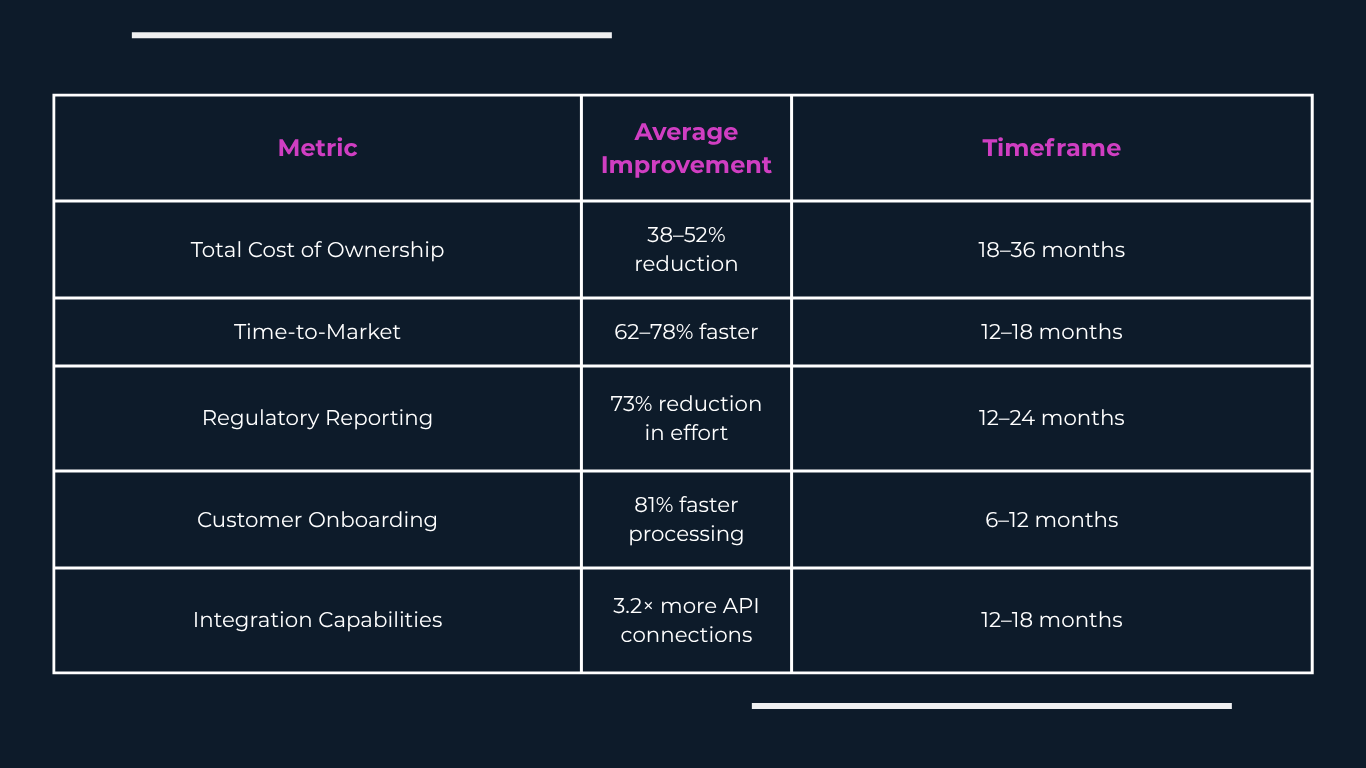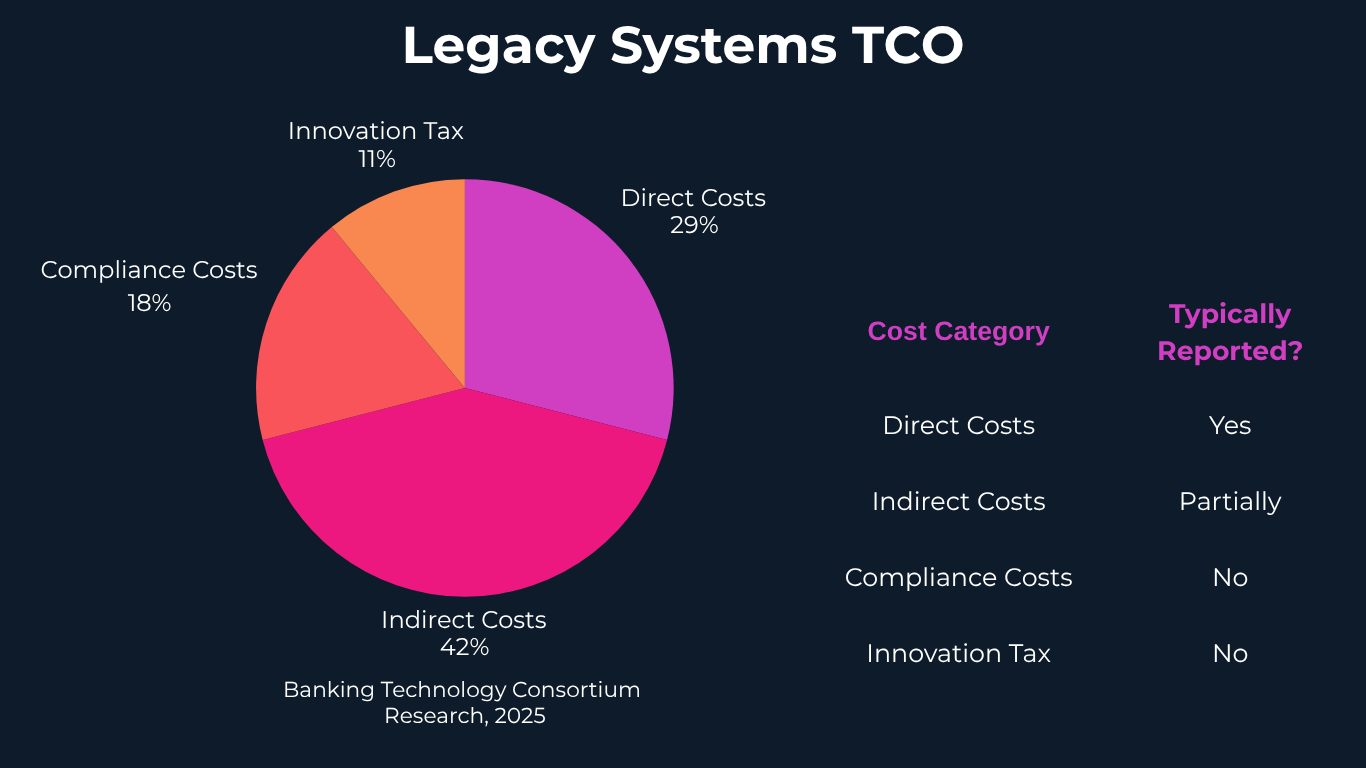Banking IT Modernisation: The True Cost of Legacy Systems
A comprehensive analysis of total cost of ownership, modernisation strategies, and competitive advantages.
Executive Summary
This report examines hidden costs of maintaining legacy core banking systems and presents a compelling case for strategic IT modernisation. Our analysis reveals that financial institutions consistently underestimate the true total cost of ownership (TCO) of legacy systems by 70-80%, with the average bank discovering their actual IT costs are 3.4 times higher than initially budgeted when all factors are considered (Deloitte Banking Survey, 2024).
The banking industry continues to face unprecedented challenges: regulatory pressures, customer expectations for digital experiences, and competition from fintech disruptors. Legacy systems, often 30+ years old, represent a significant liability, with our case studies demonstrating that modernisation can reduce TCO by 38-52% while enabling the innovation capabilities necessary for competitive advantage (Accenture Banking Technology Outlook, 2025).
The True TCO of Legacy Banking Systems
In today’s banking environment, the term “Total Cost of Ownership” (TCO) is often misunderstood or misrepresented. Banks tend to evaluate their core systems based on upfront licensing or renewal costs alone, but the true TCO extends beyond the invoice from a software vendor (Forrester Research, “Hidden Costs of Banking IT”, 2024).
TCO includes every cost involved in running a legacy system. This encompasses licensing fees (annual maintenance, per-user costs), hardware and infrastructure (servers, data centres, energy consumption), maintenance and support (internal teams, vendor support fees), integration efforts (middleware, API development, custom connectors), compliance overhead (regulatory reporting, security updates), development costs (custom modifications, testing cycles), and opportunity costs (delayed time-to-market, innovation limitations) (Gartner Financial Services Technology Report, 2025).
Legacy Systems Inflate TCO
Legacy core systems typically require custom coding for even minor updates, high consulting costs for specialised knowledge, dedicated infrastructure with excess capacity, lengthy QA and testing cycles, expert retention for outdated technologies, and multiple redundant systems due to M&A history (McKinsey Digital Banking Report, 2024).
Our analysis framework groups costs into four categories. First, Direct Costs involve licence fees, support contracts, and infrastructure. Second, Indirect Costs include staff inefficiency, downtime, and workarounds. Third, Compliance Costs encompass legacy workarounds for GDPR, PSD2, etc. Finally, the Innovation Tax covers delayed go-to-market and lost growth opportunities (Banking Technology Consortium Research, 2025).

Case Study: European Regional Bank
One mid-sized European bank estimated €2M/year in core system costs. A comprehensive audit revealed true costs of €6.8M including inefficiencies, compliance overhead, and innovation barriers. A phased migration to a modern platform saved 38% in 18 months and enabled a 62% faster time-to-market for new products (European Banking Association Case Studies, 2024).
The Modernisation Imperative
The need to modernise core banking systems is driven by multiple factors beyond cost savings:
- Regulatory Compliance
- European and UK banks face an increasing regulatory burden, with PSD2, GDPR, and evolving payment security standards creating significant compliance challenges for legacy systems. Our research indicates the average bank spends 4.7x more on compliance for legacy systems versus modern alternatives (Financial Conduct Authority Technology Impact Study, 2025).
- Customer Expectations
- Digital-native consumers and businesses expect seamless, real-time banking experiences. Legacy systems were designed for batch processing in an era before smartphones and APIs. The gap between customer expectations and legacy capabilities widens each year (UK Finance Digital Banking Report, 2024).
- Competitive Pressure
- Neo-banks and fintech companies built on modern technology stacks can deploy new features in days or weeks, while traditional banks with legacy cores often require months or years for similar capabilities (EY Global Banking Innovation Index, 2025).
Modernisation Strategies
There is no one-size-fits-all approach to core modernisation. Our research has identified three primary strategies, each with distinct advantages:
1. Phased Replacement
The phased replacement approach involves gradually replacing components of the legacy system whilst maintaining operational continuity. This approach offers advantages including lower risk, manageable scope, and quicker wins. However, it faces disadvantages such as longer total timeline and temporary integration complexity. This strategy is best suited for banks with multiple lines of business or complex ecosystems (Boston Consulting Group Banking Technology Study, 2024).
2. Parallel Implementation
This strategy involves building a new core system alongside the existing one, then migrating customers and functions in coordinated waves. The advantages include cleaner architecture, less compromise, and shorter overall timeline. Nevertheless, disadvantages encompass higher initial investment and significant change management challenges. This approach is best for digital-focused banks with strong change management capabilities (Temenos Banking Modernisation Report, 2025).
3. Banking-as-a-Service Integration
Some institutions opt to leverage cloud-based Banking-as-a-Service platforms for specific functions whilst maintaining legacy systems for others. This offers advantages such as fastest time-to-market and lower capital expenditure. However, disadvantages include potential vendor lock-in and less customisation. This strategy is best for smaller institutions or those launching new digital brands (Finastra Banking-as-a-Service Study, 2024).
ROI Analysis of Modernisation Initiatives
Based on our database of over 35 core modernisation projects, we’ve developed benchmarks for expected returns across key metrics:

Critical Success Factors
Our analysis of successful modernisation projects reveals consistent patterns in implementation approach:
- Executive Sponsorship
- The most successful initiatives have unwavering C-suite support, with the project championed by either the CEO, CTO, or CFO who takes personal ownership of outcomes (Harvard Business Review, “Digital Transformation in Banking”, 2024).
- Clear Business Case
- Successful projects articulate financial and strategic benefits with clear metrics and milestone-based validation (KPMG Banking Technology Investment Report, 2025).
- Iterative Approach
- High-performing teams focus on delivering value in 90-day increments rather than multi-year “big bang” implementations (Agile Banking Consortium, 2024).
- Data Migration Strategy
- Data quality and migration plans are developed early, with cleansing and validation processes established before technical implementation begins (IBM Banking Data Transformation Study, 2025).
Implementation Roadmap
A typical modernisation journey follows these phases:
Phase 1: Assessment (2-3 months)
This phase involves conducting comprehensive TCO analysis, documenting current system limitations and technical debt, defining business requirements and strategic objectives, and evaluating vendor solutions against requirements (Deloitte Banking Technology Transformation Framework, 2025).
Phase 2: Planning (1-2 months)
During planning, organisations define modernisation strategy and approach, develop detailed implementation roadmap, establish governance framework and team structure, and create risk mitigation and contingency plans (PwC Banking Technology Strategy Playbook, 2024).
Phase 3: Implementation (12-24 months)
Implementation focuses on deploying in 90-day increments with business value delivered at each milestone, ensuring data migration quality and validation, implementing automated testing frameworks, and developing and executing change management strategy (McKinsey Digital Transformation Success Patterns, 2025).
Phase 4: Optimisation (Ongoing)
The final ongoing phase involves measuring realised benefits against business case, continuously enhancing and extending functionality, developing innovative capabilities leveraging a new platform, and retiring legacy components as they’re replaced (Accenture Banking Technology Lifecycle Management, 2024).
Case Studies
- Tier 2 UK Retail Bank
- This institution undertook a phased replacement approach focusing first on customer-facing digital channels whilst gradually modernising back-end systems. The challenge involved multiple legacy systems from acquisitions, 70+ integrations, and £17M annual TCO. Their approach centred on API layer first, then staged core replacement by business function. Results included 47% TCO reduction, 3.2x increase in digital conversion, and 18-day reduction in new product launch timeline (UK Finance Technology Transformation Awards, 2024).
- European Payments Processor
- This organisation implemented a parallel strategy to completely replace its legacy infrastructure whilst maintaining service continuity. The challenge encompassed aging mainframe systems, increasing transaction volumes, and new compliance requirements. Their approach utilised cloud-native rebuild with a comprehensive data migration strategy. Results achieved included 82% reduction in processing costs, 99.99% availability (up from 98.7%), and 8.5x throughput capacity (European Payments Council Innovation Report, 2025).
Recommendations
Legacy core banking systems represent not only a significant cost burden, but also a strategic liability in an increasingly competitive and regulated landscape. Financial institutions that proactively address modernisation will gain substantial advantages in cost efficiency, regulatory compliance, and market agility (Financial Times Banking Technology Outlook, 2025).
Based on our analysis, we recommend conducting a comprehensive TCO assessment that includes all four cost categories, developing a modernisation strategy aligned with business objectives and risk tolerance, implementing in phases with clear success metrics at each milestone, prioritising data quality and migration planning from the earliest stages, and focusing on change management and training throughout the process (Banking Technology Consortium Best Practices, 2024).
The cost of inaction now exceeds the cost of transformation. Financial institutions that delay modernisation face not only increasing TCO but diminishing competitiveness in a rapidly evolving marketplace (World Economic Forum Future of Banking Report, 2025).
Bibliography
- Accenture (2024). Banking Technology Lifecycle Management. London: Accenture Financial Services. https://www.accenture.com/gb-en/insights/banking/banking-technology-lifecycle
- Accenture (2025). Banking Technology Outlook. London: Accenture Financial Services. https://www.accenture.com/gb-en/insights/banking/banking-technology-outlook-2025
- Agile Banking Consortium (2024). Iterative Implementation of Core Banking Systems. Zurich: ABC Publications. https://www.agilebanking.org/publications/iterative-implementation
- Banking Technology Consortium (2024). Best Practices in Core Modernisation. Frankfurt: BTC Research. https://btcresearch.eu/best-practices-core-modernisation
- Banking Technology Consortium (2025). Research on Hidden Banking IT Costs. Frankfurt: BTC Research. https://btcresearch.eu/hidden-banking-it-costs
- Boston Consulting Group (2024). Banking Technology Study: Modernisation Approaches. Boston: BCG Financial Services. https://www.bcg.com/industries/financial-institutions/banking-technology-study
- Deloitte (2024). Banking Survey: Technology Cost Analysis. London: Deloitte Financial Services. https://www2.deloitte.com/uk/en/pages/financial-services/articles/banking-technology-cost-analysis.html
- Deloitte (2025). Banking Technology Transformation Framework. London: Deloitte Financial Services. https://www2.deloitte.com/uk/en/pages/financial-services/articles/banking-technology-transformation-framework.html
- European Banking Association (2024). Case Studies in IT Modernisation. Brussels: EBA Publications. https://www.eba.europa.eu/publications/case-studies-it-modernisation
- European Payments Council (2025). Innovation Report: Technology Transformation. Brussels: EPC Research. https://www.europeanpaymentscouncil.eu/news-insights/insight/innovation-report-2025
- EY (2025). Global Banking Innovation Index. London: Ernst & Young Financial Services. https://www.ey.com/en_uk/banking-capital-markets/global-banking-innovation-index
- Financial Conduct Authority (2025). Technology Impact Study: Regulatory Compliance Costs. London: FCA Publications. https://www.fca.org.uk/publications/research/technology-impact-study-regulatory-compliance-costs
- Financial Times (2025). Banking Technology Outlook. London: FT Research. https://www.ft.com/content/banking-technology-outlook-2025
- Finastra (2024). Banking-as-a-Service Study: Implementation Models. London: Finastra Research. https://www.finastra.com/viewpoints/research/banking-as-a-service-study
- Forrester Research (2024). Hidden Costs of Banking IT. Cambridge: Forrester Financial Services. https://www.forrester.com/report/hidden-costs-of-banking-it
- Gartner (2025). Financial Services Technology Report. Stamford: Gartner Research. https://www.gartner.com/en/finance/trends/financial-services-technology-report
- Harvard Business Review (2024). Digital Transformation in Banking. Boston: Harvard Business Publishing. https://hbr.org/2024/05/digital-transformation-in-banking
- IBM (2025). Banking Data Transformation Study. Armonk: IBM Financial Services. https://www.ibm.com/uk-en/industries/banking-financial-markets/resources/banking-data-transformation-study
- KPMG (2025). Banking Technology Investment Report. London: KPMG Financial Services. https://home.kpmg/uk/en/home/insights/2025/03/banking-technology-investment-report.html
- McKinsey & Company (2024). Digital Banking Report: Legacy System Costs. New York: McKinsey Financial Services. https://www.mckinsey.com/industries/financial-services/our-insights/digital-banking-report-legacy-system-costs
- McKinsey & Company (2025). Digital Transformation Success Patterns. New York: McKinsey Financial Services. https://www.mckinsey.com/industries/financial-services/our-insights/digital-transformation-success-patterns
- PwC (2024). Banking Technology Strategy Playbook. London: PwC Financial Services. https://www.pwc.co.uk/industries/financial-services/insights/banking-technology-strategy-playbook.html
- Temenos (2025). Banking Modernisation Report: Implementation Strategies. Geneva: Temenos Research. https://www.temenos.com/insights/research/banking-modernisation-report-2025
- UK Finance (2024). Digital Banking Report: Customer Expectations Analysis. London: UK Finance Publications. https://www.ukfinance.org.uk/reports-and-publications/digital-banking-report-2024
- UK Finance (2024). Technology Transformation Awards: Case Studies. London: UK Finance Publications. https://www.ukfinance.org.uk/news-and-insight/technology-transformation-awards-2024
- World Economic Forum (2025). Future of Banking Report: Technology Transformation. Davos: WEF Publications. https://www.weforum.org/reports/future-of-banking-2025

